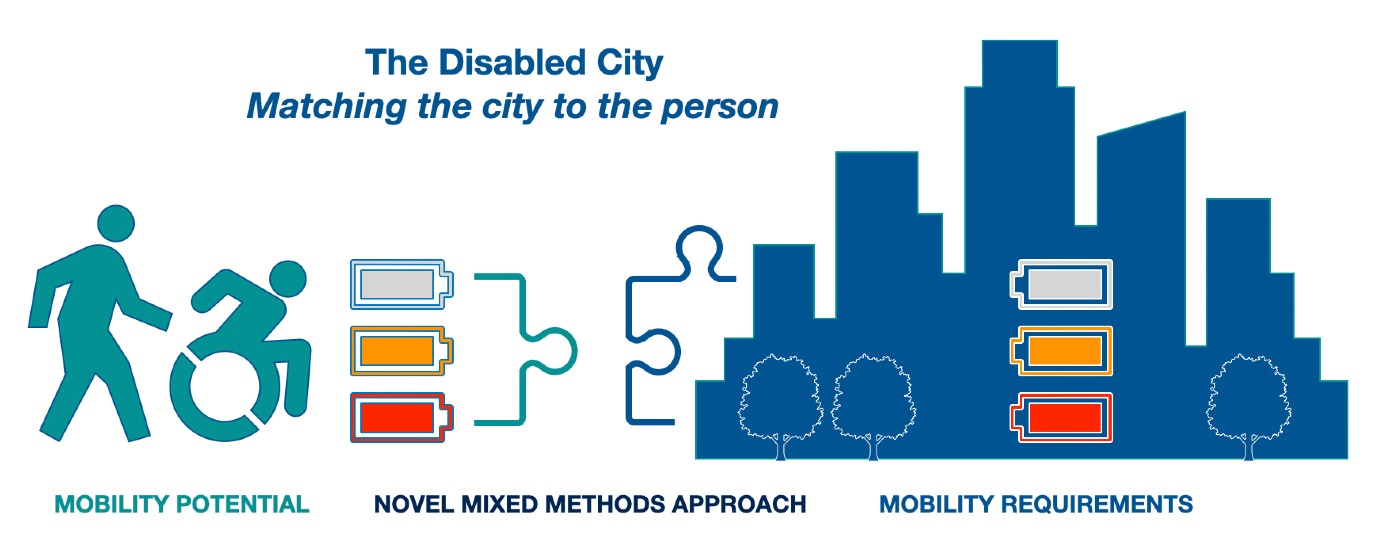A mismatch between city and individual

For many people, taking a walk around the block is something they hardly think about, but for people with physical disabilities it is not nearly as straightforward. A new M20 study examines the mismatch between the city and the individual. “There are a lot of barriers for people with physical disabilities that are not being considered,” says professor of health geography Louise Meijering.
The city has a lot of barriers for people with physical disabilities, Meijering argues. "Many people immediately think of physical barriers in public spaces. For example, a pavement you cannot easily get on or off with a wheelchair, or an uneven surface. But it's not just about those kinds of barriers. Think about supermarkets too, for example, can you reach the products you need if they are higher on the shelves?"
In addition, social factors also play an important role. Imagine having to get from a hospital appointment to the train station in a wheelchair. “That in itself is quite a challenge, because nine times out of 10 the road is being worked on or there is a car on the pavement,” explains assistant professor of Movement Sciences Riemer Vegter. “But try that at five in the afternoon, when there are about 10,000 bikes and lots of pedestrians on that same road. Do people even take you as a wheelchair user into account?”
“People with physical disabilities experience a mismatch in their potential mobility and the mobility requirements of the environment; the environment demands more of them than they are able to do,” Meijering says. Meijering and Vegter, together with Juha Hijmans, associate professor at the UMCG Centre for Rehabilitation, and Ward Rauws, associate professor spatial planning, have initiated research into this mismatch between the city and the individual thanks to an M20 grant.
Complex problem
The front door is the boundary between the relatively simple home environment and the complex outdoor environment. It is already quite difficult to properly adapt a home for wheelchair users, but there we at least know better what needs to be done, Meijering argues. "In the city, it is a lot more difficult. At home, you and your family members are the only users of the space. When you go outside, suddenly there are many more users, and it is more complicated to make the space accessible to everyone."
“We often try to get someone in a wheelchair to be able to participate as well as possible, but sometimes we do so without knowing exactly what is required by the environment,” says Vegter. By making the connection between the person's potential mobility and the city's mobility requirement, the researchers hope to gain insight into where more needs to be done. "Then we will know where we need to tinker. Should the user's potential mobility be increased or should the city's mobility requirement be reduced? That's what we want to find out,” Vegter states.
According to Vegter and Meijering, without experience, it is impossible to address this mismatch because we do not yet know well enough what the limiting factors are. “It's not about the barriers we think people with physical disabilities experience, we don't have their individual impairments and therefore can't assess that. The policymakers who make choices about facilities are in the same kind of situation,” Vegter explains. To make it clearer, he gives an example of a ping-pong table placed next to a building, where upward air is constantly flowing past it, preventing you from hitting a ball. “Someone figured that a ping-pong table would look nice there without thinking carefully about the context. That also seems to be the case when it comes to policies for people with disabilities,” Vegter says.
To remedy this, the researchers initially want to go outside with people with disabilities. In so-called go-along interviews, they will get a better picture of the subjective experience of the person with a physical disability. The researchers want to combine these subjective experiences with objectively measured information such as GPS data to better understand how an individual with a physical disability functions in an environment.
In addition, the researchers also aim to get policymakers to experience what it is like to move through the city in a wheelchair, that way policymakers can speak from experience about what needs to change. The next step in this is to bring people with physical disabilities, their families, care workers, spatial planners and policymakers together and pool all that knowledge to find out together what is necessary for a more inclusive environment. ”To avoid putting the ping-pong table in the wrong place,” says Meijering.
Interdisciplinary work
The new research is an interdisciplinary project in which health geography, spatial planning, rehabilitation and movement sciences all play a role. The project has not yet officially started: the researchers are still working hard to find the right candidate for the PhD position in the project. “As soon as we find the PhD candidate, everything will really start,” says Vegter.
Although the project has not yet started, Vegter and Meijering are already noticing the benefits of interdisciplinary cooperation. "We have visited and talked to each other a lot recently. We already notice how much we enrich one another with our ideas. We have already learned a lot from each other,” both agree.
The project was funded by The Ubbo Emmius Foundation as part of the 2023 M20 scholarships through the Aletta Jacobs School of Public Health. The M20 scholarships were created to support interdisciplinary projects and give researchers the finances needed to appoint a PhD student. “It's fantastic to get this opportunity, it feels like a gift,” says Vegter. "It's hard to get this kind of project funded. When you get a chance to carry it out it gives a lot of energy."
More news
-
15 September 2025
Successful visit to the UG by Rector of Institut Teknologi Bandung


